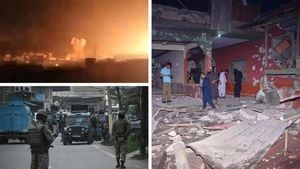On July 15, 2024, the political scene in Nepal witnessed yet another shake-up as President Shri Ram Chandra Paudel appointed K P Sharma Oli as the new Prime Minister, heading up the coalition between the Communist Party of Nepal-Unified Marxist Leninist (CPN-UML) and the Nepali Congress (NC). This marked the appointment of Nepal’s 14th Prime Minister within 15 years—a number that's bafflingly high for any democratic setup. According to the power-sharing agreement reached on July 1, 2024, both Oli and NC's Sher Bahadur Deuba will alternate as prime ministers, each wielding power for 18 months before moving toward the next general elections slated for 2027.
But, as the dust settles from this political reshuffling, two pressing questions loom large over Nepal: What does this coalition mean for the nation's political stability? And can this government effectively tackle its worsening economic and geopolitical issues, particularly its relationships with India and China?
It's much like viewing one of Monet's Impressionist works—one must step back to truly grasp the whole picture made up of fragmented brushstrokes. The long-standing political instability of Nepal stems from its complex history with democracy, which is still very much under construction. A closer look reveals how these contemporary events connect with the struggles of the past, especially those linked to the country's geopolitical tensions.
Nepal's political history has been teetering on the edge of precariousness, intertwined with economic challenges. King Prithvi Narayan Shah’s unification process back in 1768 marked the beginning of centralized monarchy rule, which lasted well until 1951. The end of the Rana regime saw initial democratic efforts take shape, but the road was far from smooth. Frequent cabinet reshuffles led to governmental instability, resulting in five different governments from 1951 to 1958 alone.
The Nepali Congress emerged victorious during the elections on February 18, 1959, leading to BP Koirala's appointment as Prime Minister. Unfortunately, dreams of democracy were short-lived as King Mahendra imposed his rule, dissolving political parties and establishing the Panchayat system, which took decades to overturn. It wasn’t until 1990, after years of agitation, did Nepal adopt multiparty democracy under constitutional monarchy.
This newly established governance faced severe challenges, especially following the tragic 2001 royal massacre, which destabilized the monarchy. Concurrently, Nepal's Maoist insurgency dangled the specter of civil conflict, plaguing the nation with unrest for years. Finally, the Constituent Assembly declared Nepal as a Federal Democratic Republic on May 28, 2008, putting away the monarchical system of governance.
The constitution drafted and adopted by the Constituent Assembly in 2015 came about amid much opposition from various factions, particularly the Madhesis and some ethnic groups who felt sidelined. Despite their concerns, this was another step toward political empowerment—and yet, the country has grappled with creating and maintaining stable governance.
Over the years, Nepal has drafted seven constitutions (1948, 1951, 1959, 1962, 1990, 2007, and 2015), forming part of its continued struggle to establish effective political frameworks. The recent arrangement between the Nepali Congress and CPN-UML, where K.P. Sharma Oli and Sher Bahadur Deuba will swap roles as Prime Minister, has stirred expectations, but historical precedent warns of potential failure.
Numerous coalitions have previously faltered at the altar of political rivalry and strife. For example, the merger of CPN-UML with Maoist Centre formed the Nepal Communist Party (NCP) had to be disbanded after merely three years, with personal rivalries and senior members’ egos tearing the party apart. Consequently, Nepal has experienced over a dozen shifts in government since the monarchy's dissolution, showcasing the fragility of its democratic process.
Yet, political instability isn't the only thorn on Nepal's side. Economic woes are taking center stage. The International Monetary Fund (IMF) raised alarms back in December 2023, warning of impending strains on the financial system if the nation continues to ignore the troubling observations made by the Financial Action Task Force (FATF). An on-the-ground visit by officials highlighted glaring deficiencies within Nepal’s compliance to anti-money laundering norms, coupled with inadequate criminalization protocols for private sector corruption.
Former Prime Minister Pushpa Kamal Dahal's claims of achievements back in January 2024, amid climbing unemployment rates, delivered little more than hollow promises to the public. At the same time, the nation grappled with problems like trade deficits, widespread unemployment, plummeting agricultural outputs, and declining hotel and restaurant activities.
With agriculture being the lifeblood of the Nepali economy—engaging over 70% of the workforce—it's concerning to see its dwindling productivity. Once capable of exporting rice, Nepal has had to rely on imports for the past few years, purchasing approximately 1.4 million tons from India, costing nearly half a billion dollars. Food inflation averaging 7.74% also looms larger than ever, pushing the cost of living even higher. The dire job situation prompted around 750,000 people to seek employment outside of the country during the 2022-23 period, leading to ghost villages where once-vibrant communities flourished.
Geographically, Nepal’s position between two massive nations—India and China—has heavily influenced its international relations. The nation’s historical ties with India run deep, owing to shared cultural practices, geographic proximity, and extensive family connections, but more often than not, these ties are tested by geopolitical maneuvers.
China first engaged with Nepal following its annexation of Tibet back in 1950, initially focused on limiting Tibetan anti-China sentiment within Nepal. Over the years, this relationship matured, resulting now in deep connections across various fronts, including infrastructure, development aid, and investment. Amid this evolution, the Belt and Road Initiative (BRI) has become increasingly central to China’s engagement strategy with Nepal.
Now, with the dust settling from Nepal's coalition dynamics, the new government under K.P. Sharma Oli is expected to face the trials of balancing Nepal's foreign relations, particularly pertaining to its ties with India and China. Observers may note the visible shift as Oli prepares for his first official visit to China, breaking the long-standing tradition of newly appointed prime ministers visiting India instead. This contemporary pivot may symbolize subtle changes to come within Nepal’s foreign policy framework. Reports even indicate this visit, planned for early December 2024, reflects a significant assertion of Nepal's independent diplomatic stance—a move away from the historically pro-India tendencies of previous governments.
Oli’s coalition, with its pro-China inclinations, has raised eyebrows amid tensions between the major parties over how to navigate China’s Belt and Road Initiative projects currently on the table. While CPN-UML advocates for obtaining loans from China’s Exim Bank to fund BRI projects, the Nepali Congress calls for acceptance of only grant-based agreements. These contrasting approaches toward international investment highlight the internal struggles within Nepal's government, which could complicate broader diplomatic relations.
The backdrop of Nepal’s changing political atmosphere and economic hardships paired with the geopolitical tug-of-war with India and China makes for a fascinating, though tumultuous, analysis of its present and future. Understanding these intersections is wrought with complexity, emphasizing the need for stability and unity among Nepali leadership to steer away from perpetual contention.
These dynamics reveal the challenge of forging lasting stability as long-term solutions remain unattainable amid chronic governmental instability. For now, the balance of power between India and China will likely remain pivotal to Nepal’s national interests, and how quickly and effectively Nepal can navigate these waters will depend largely on how its leaders learn to unite and focus on the pressing issues at hand.



